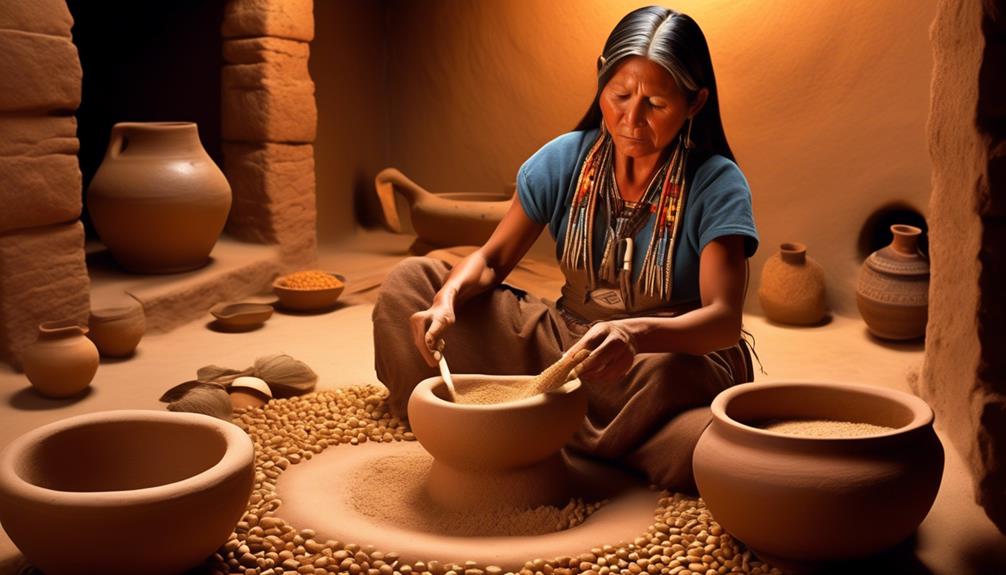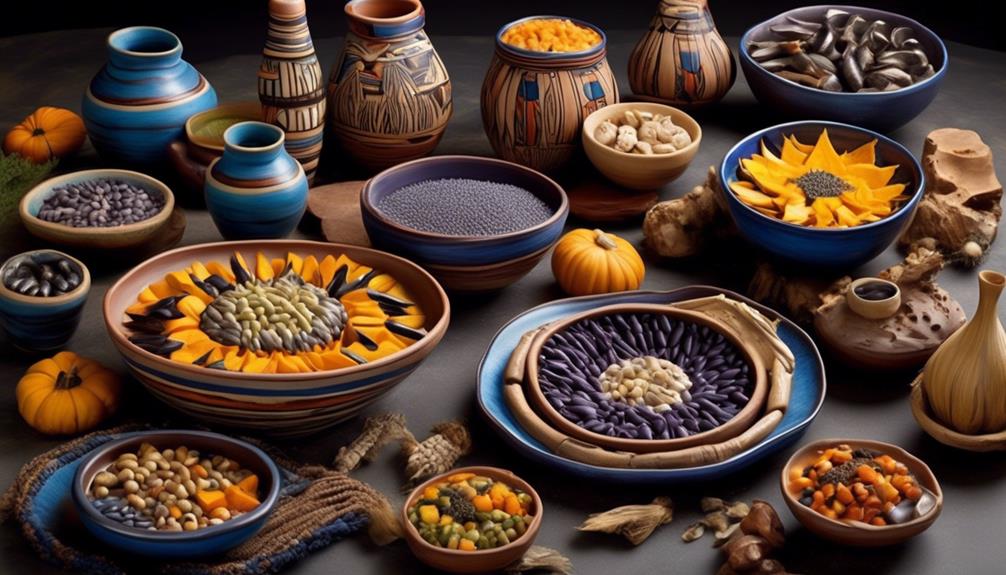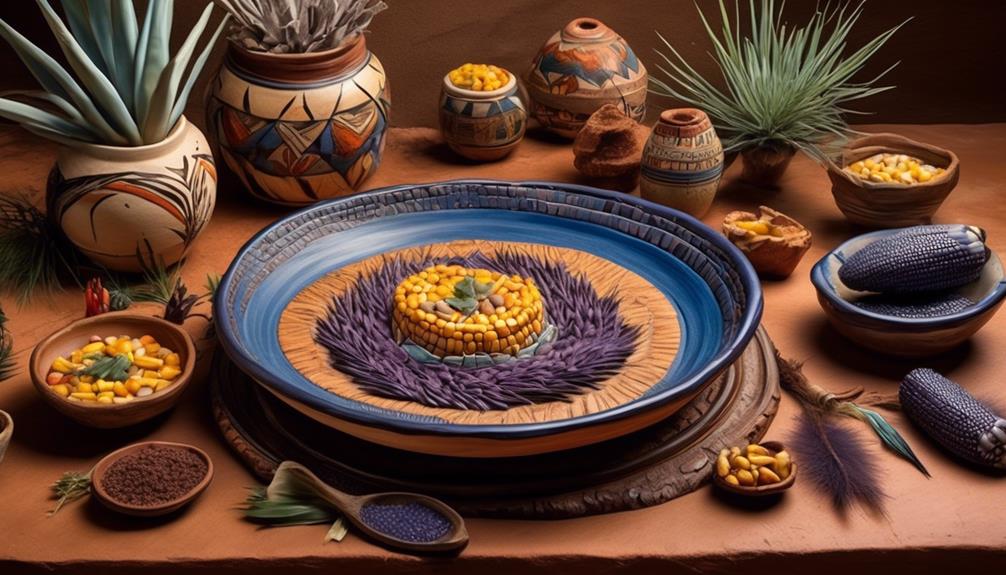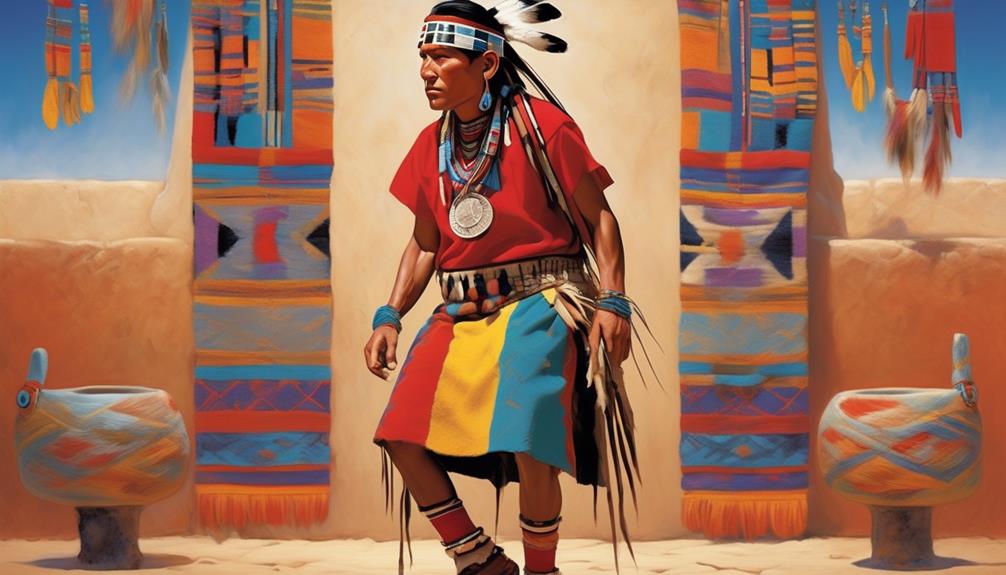As cooking enthusiasts, we are frequently intrigued by the traditional diets of indigenous tribes, like the Hopi Indian Tribe. The Hopi individuals maintain a deep bond with their land and food, which is evident in their traditional culinary practices.
From their use of blue corn to their unique farming techniques, the Hopi diet offers a fascinating glimpse into a rich culinary tradition that has been passed down through generations.
But what exactly are the staple foods of the Hopi Tribe, and how do they prepare their meals to preserve both flavor and cultural significance?
Key Takeaways
- The staple foods of the Hopi tribe are corn, beans, and squash, known as the 'Three Sisters'.
- Traditional cooking techniques such as underground ovens and clay pottery are used in Hopi cuisine.
- Hopi cuisine has been influenced by neighboring Pueblo tribes and Spanish culinary techniques.
- Food holds significant cultural and spiritual importance in Hopi culture, and is used for celebration, connection, and storytelling.
Staple Foods of the Hopi Tribe
The staple foods of the Hopi tribe include corn, beans, and squash, which form the cornerstone of their traditional diet and cultural practices. These three crops, known as the 'Three Sisters,' are revered for their symbiotic relationship in the garden and their nutritional value.
Corn is seen as the most important crop, symbolizing life and fertility, and is used in various traditional recipes such as piki bread, a paper-thin, delicate bread made from blue corn. Beans, representing support and strength, are often included in stews and soups. Squash, signifying protection, is used in dishes like stewed squash with chilies.
The traditional recipes utilizing these staple foods have been passed down through generations, carrying deep cultural significance. The cultivation and consumption of these crops are integral to Hopi ceremonies and rituals, connecting the tribe to their ancestors and the land.
Understanding the traditional preparation of these foods not only allows us to appreciate the flavors but also the cultural heritage and spiritual significance they hold for the Hopi people.
Traditional Hopi Cooking Techniques

Exploring traditional Hopi cooking techniques reveals the intricate methods that have been utilized to prepare the staple foods of the tribe, symbolizing a deep connection to their cultural heritage and the land. Traditional cooking methods among the Hopi Tribe are deeply rooted in their spiritual and cultural practices. The ceremonial feasts hold a special significance, and the preparation of food for these occasions involves unique techniques that have been passed down through generations. One of the most notable traditional cooking methods is the use of underground ovens, known as hornos, for baking bread and roasting meats. This technique imparts a distinct earthy flavor to the food, enhancing its cultural significance. Another traditional method involves using grinding stones to process corn into meal, a labor-intensive process that highlights the tribe's dedication to preserving their culinary heritage. The following table provides a glimpse into the traditional Hopi cooking techniques:
| Traditional Cooking Technique | Description |
|---|---|
| Underground Ovens (Hornos) | Used for baking bread and roasting meats |
| Grinding Stones | Utilized for processing corn into meal |
| Clay Pottery | Cooking vessels used for various dishes |
| Sun-Drying | Method for preserving fruits and vegetables |
These traditional cooking techniques exemplify the Hopi Tribe's commitment to honoring their cultural traditions, especially during ceremonial feasts.
Culinary Influences on Hopi Cuisine
Influences from neighboring tribes and Spanish colonial settlers have significantly shaped the evolution of Hopi cuisine, introducing new ingredients and culinary techniques to the traditional food practices of the tribe.
The culinary traditions of the Hopi people have been influenced by the Pueblo tribes, resulting in the integration of corn, beans, and squash into their diet. The introduction of sheep by the Spanish also brought mutton into Hopi cuisine, leading to the creation of dishes like mutton stew and roast mutton. Additionally, the Spanish introduced new culinary techniques such as roasting and frying, which have become modern adaptations in Hopi cooking.
The fusion of these culinary influences has added depth and variety to Hopi cuisine while still honoring the tribe's traditional cooking methods.
Today, Hopi culinary traditions continue to evolve, with the integration of modern ingredients and cooking techniques alongside the traditional practices. This blend of old and new allows the tribe to preserve its rich culinary heritage while embracing the innovations that enhance their culinary experiences.
Importance of Food in Hopi Culture

Drawing from the rich culinary influences that have shaped Hopi cuisine, we can now explore the significance of food in Hopi culture. Food holds a central place in our traditions, serving as a means of celebration, connection, and storytelling.
Celebration feasts are a vital part of our culture, bringing together the community to honor significant events such as harvests, weddings, and religious ceremonies. These feasts not only nourish the body but also nourish the bonds between individuals, fostering a sense of unity and shared purpose.
Furthermore, food plays a crucial role in our agricultural rituals, symbolizing our deep connection to the land and the natural world. Planting, harvesting, and storing food are accompanied by meaningful ceremonies that express gratitude to the earth and invoke blessings for abundant crops. Through these rituals, we honor the wisdom of our ancestors and pass down the value of sustainable living to future generations.
In essence, food is intertwined with every aspect of our culture, serving as a means of sustenance, connection, and reverence. Its significance goes beyond mere nourishment, embodying our heritage, beliefs, and values.
Unique Flavors and Ingredients in Hopi Dishes
Embracing the rich tapestry of our culinary heritage, the unique flavors and ingredients found in traditional Hopi dishes reflect our deep connection to the land and the vibrant history of our people. Hopi food traditions are deeply rooted in the use of indigenous ingredients that have sustained our community for generations. Our dishes are characterized by a harmonious blend of earthy, smoky, and robust flavors that are achieved through the use of traditional cooking methods and locally sourced ingredients.
| Unique Flavors | Indigenous Ingredients | Traditional Dishes |
|---|---|---|
| Earthy | Blue corn | Piki bread |
| Smoky | Juniper berries | Hominy stew |
| Robust | Sunflower seeds | Bean and squash soup |
The earthy taste of blue corn is a staple in many Hopi dishes, providing a distinct flavor and vibrant color to traditional foods like piki bread. Juniper berries add a smoky essence to hominy stew, while sunflower seeds contribute a rich and robust flavor to bean and squash soup. These indigenous ingredients not only infuse our dishes with unique flavors but also serve as a testament to the sustainable and resourceful practices that have been integral to our culture for centuries.
Frequently Asked Questions
What Are the Specific Health Benefits of the Staple Foods in the Hopi Diet?
We've explored the specific health benefits of the staple foods in the Hopi diet.
These traditional foods offer a multitude of health advantages, including high nutritional value, such as protein, fiber, and essential vitamins.
The cultural significance of these staple foods lies in their connection to traditional practices and the preservation of the tribe's heritage.
The Hopi diet, rooted in natural and wholesome ingredients, not only nourishes the body but also honors their cultural heritage.
Are There Any Specific Rituals or Ceremonies Related to Food Preparation and Consumption in Hopi Culture?
Rituals and celebrations hold great significance in Hopi culture, especially in relation to food preparation and consumption. Traditional ceremonies are deeply intertwined with the cultivation and harvesting of staple foods, reflecting our reverence for nature and the land.
Food preparation is seen as a communal activity, fostering unity and connection within the tribe. The rich cultural significance attached to these rituals highlights the deep-rooted traditions and values that shape our way of life.
How Has Modernization and Outside Influences Affected the Traditional Hopi Diet?
Modernization and outside influences have had a profound impact on the traditional Hopi diet. Dietary changes, like the introduction of processed foods and modern cooking methods, have challenged cultural preservation efforts.
This has led to a shift away from traditional foods like corn, beans, and squash towards more convenience foods.
Despite these challenges, the Hopi tribe continues to prioritize the preservation of their cultural food practices.
Are There Any Specific Rules or Taboos Surrounding Food and Eating in Hopi Culture?
Taboos, restrictions, and cultural significance heavily influence Hopi food customs. Traditional practices dictate dietary norms and eating behaviors. Specific rules govern food preparation, consumption, and sharing, reflecting the tribe's deep-rooted beliefs and values.
These customs ensure respect for the land and its offerings, fostering a harmonious relationship with nature. Understanding these taboos and restrictions is essential for preserving the integrity of the Hopi culture and honoring their ancestral traditions.
What Are Some Lesser-Known, but Important, Ingredients Used in Traditional Hopi Dishes?
When it comes to traditional ingredients, the Hopi tribe incorporates unique elements like blue corn, sumac, and Juniper ash into their culinary practices. These ingredients hold significant cultural importance, playing a vital role in traditional dishes.
Many of these lesser-known ingredients are also tied to food taboos, reflecting the deep cultural significance of Hopi cuisine. Understanding these elements enriches our appreciation of the tribe's rich culinary heritage.
Conclusion
In conclusion, the Hopi Indian tribe's diet is rich in traditional and staple foods such as corn, beans, and squash.
Their unique cooking techniques and culinary influences have shaped their cuisine into a colorful and flavorful experience.
The importance of food in Hopi culture can't be understated, as it brings together family and community in a way that's both nourishing and spiritually fulfilling.
So, have you ever tried the unique flavors and ingredients found in Hopi dishes?









